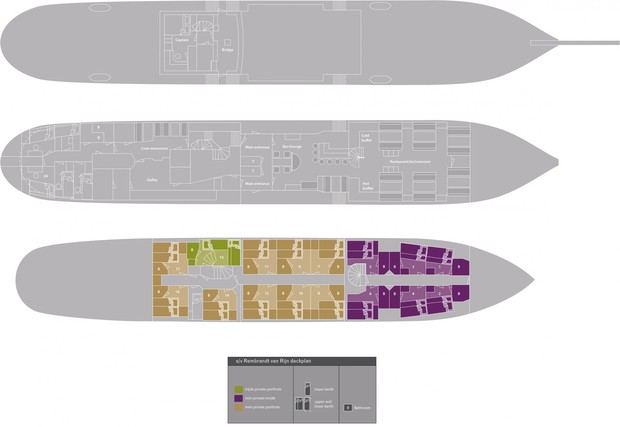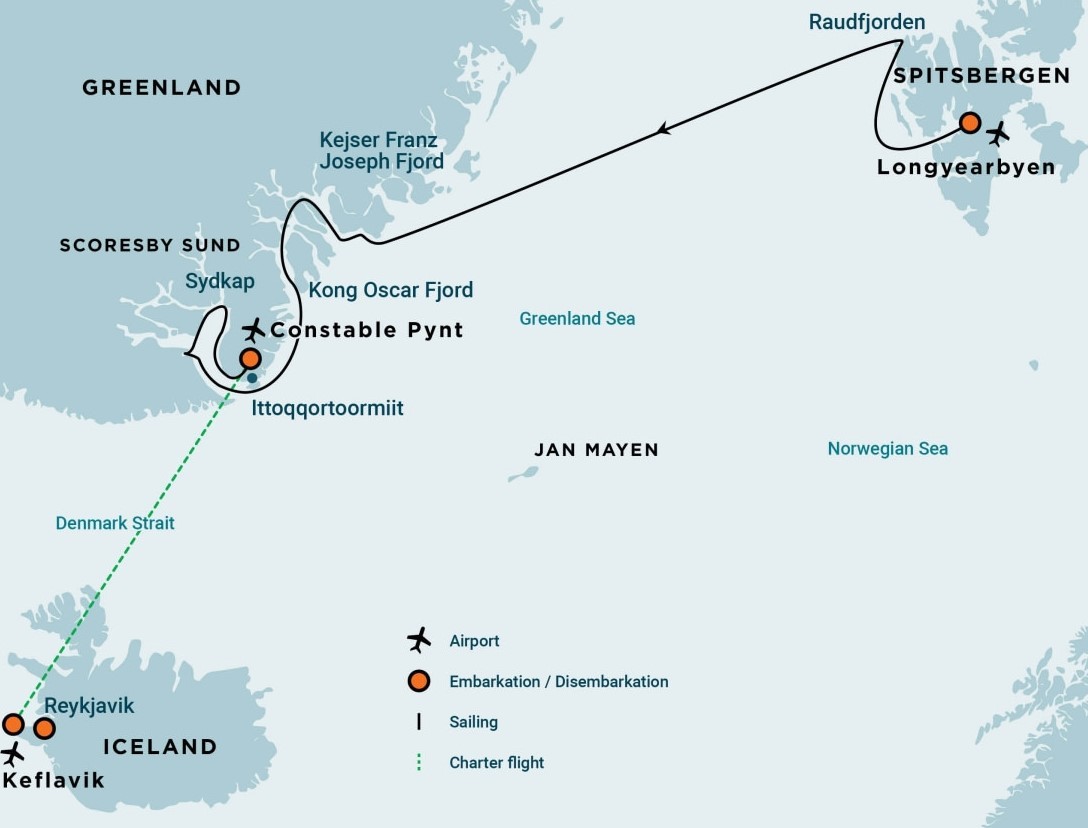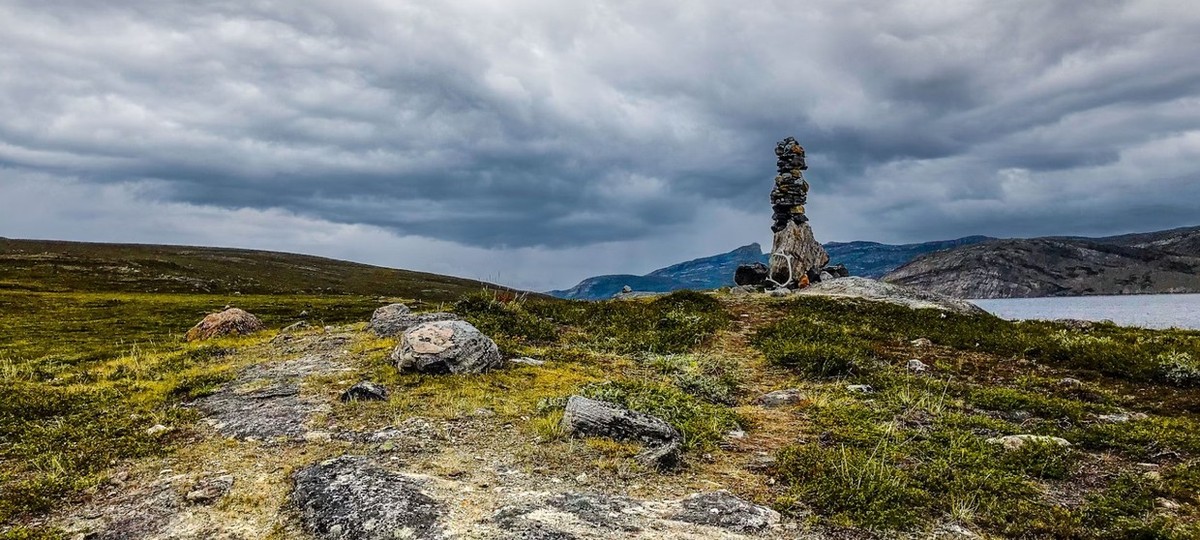
The Spitsbergen and Northeast Greenland cruise sails waters filled with breath-taking scenery. The expedition passes through areas that are home to seals, seabirds, whales, and polar bears.
- Kaiser Franz Joseph Fjord - This large East Greenland fjord system lies between Cape Mackenzie and Cape Franklin
- Jameson Land - A peninsula in eastern Greenland, Jameson Land is known for its striking geological formations
- Arctic Hare - They can run like the wind, see everything around them without turning their heads, and sometimes eat animals instead of leaves – all while looking this cute
- Musk Ox - Among the few hooved animals to survive the last ice age, these goat-like creatures have an underlayer of fur that is one of the world's warmest natural fibers
- Svalbard reindeer - Saved from the brink of extinction by dedicated recovery programs, these small reindeer have a dramatically variable birth rate
Prices quoted here are often dependent on currency fluctuations. Please check with (01432 507450 or info@small-cruise-ships.com) for the very latest price, which may well be cheaper than the one advertised here.


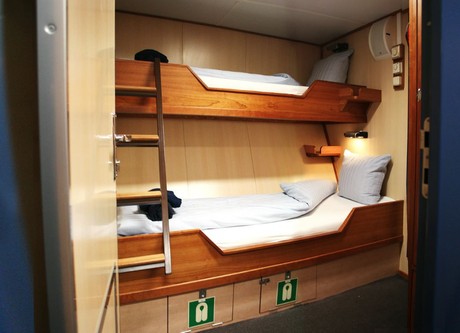
You touch down in Longyearbyen, the administrative center of Spitsbergen, the largest island of the Svalbard archipelago. Enjoy strolling around this former mining town, whose parish church and Svalbard Museum make for fascinating attractions. Though the countryside appears stark, more than a hundred species of plant have been recorded in it. In the early evening the ship sails out of Isfjorden, where you might spot the first minke whale of your voyage. In the evening you sail for Trygghamna, where you see the remains of a 17th-century English whaling station and 18th-century Pomor hunting station, both of which you can visit the next morning.
From Trygghamna you walk to Alkhornet, a large seabird cliff where the birds are scouting out breeding places. Below the cliffs is a common place to spot Arctic foxes, and you may also see reindeer grazing on the lush vegetation if there’s not too much snow.
You sail into Fuglefjorden amid views of Svitjodbreen and Birgerbukta, both breeding places for great skuas as well as likely spots to spy a polar bear. Raudfjorden, on the north coast of Spitsbergen, is a fine area for gazing over the glaciers. It’s also a favorite hangout for ringed and bearded seals, colonies of seabird, and the occasional polar bear and beluga whale.
You may eventually see the jagged edge of the east Greenland sea ice flashing into sight ahead, depending on the conditions. Keep watch for whales and migrating seabirds here.
The goal is to sail into Foster Bay, making your first landing at Myggbukta in the late afternoon or evening. Beyond the old hunters’ hut (where, in the first half of the 20th century, Norwegian trappers hunted for polar bear and Arctic fox) there is a sprawling tundra populated by musk oxen, with geese floating the small lakes.
You sail through Kaiser Franz Josef Fjord, enjoying its lofty mountains and bright interior icebergs. In the evening you reach Teufelsschloss, a prominent mountain that comprises part of the Eleonora Bay Supergroup: sedimentary rock created between 950 – 610 million years ago to a depth of 16 km (10 miles). This rust-red multi-layered unique geology defines the scenery over the coming days.
Landing at Blomsterbugten, you have a good chance of spotting Arctic hare and musk oxen. Noah Lake is home to great northern divers as well as their young, and the hiking opportunities here are numerous. In the afternoon you venture deeper into Kaiser Franz Joseph Fjord, finding shelter in Renbugten. Colossal icebergs and quintessential Arctic scenery accompany you while passing through this narrow fjord system.
Today the aim is to land in Renbugten in search of musk oxen and Arctic hares. Around lunch you head east into the inversely named Antarctic Sound, enjoying views of the ancient sedimentary rock. You should arrive at Maria Island before nightfall.
You cut into Kong Oscars Fjord for an attempted landing near Menander Øer, a location with lively walking opportunities.
Continuing east, you land in Antarctic Havn. You spend the afternoon in this expansive valley, where you can see groups of musk oxen. At this time of year, the sparse vegetation is colored with golden fire. Your guide may be able to tell you about the intriguing geopolitics that played out here in the early 1930s between Norway and Denmark.
Spending the day at sea, you make for the largest fjord system in the world: Scoresbysund.
Today you reach Scoresbysund, sailing along the glaciated Volquart Boons Kyst. You may also enjoy a Zodiac cruise past one of the glacier fronts, along with a visit to the basalt columns and ice formations of Vikingebugt. The afternoon goal is to visit Danmark Island, where you find the remains of an Inuit settlement abandoned around 200 years ago. The circular stone tent rings indicate the summer houses, while the winter houses can be seen closer to a small cape. The sites are well preserved, with easy identifiable entrances, bear-proof meat caches, and grave sites. During the afternoon, you sail along the east side of Milne Land amid a number of scattered icebergs.
You land near Sydkap, where Arctic hares are often seen, and during lunch you get a glimpse of the entrance to Nordvestfjord in Scoresby Land. Here you encounter colossal icebergs, some over 100 meters high (328 feet) and more than a kilometer in length (.6 mile). Most of these bergs are grounded, as the fjord is only about 400 meters deep (1,312 feet).
At the western shores of Jameson Land lies a vast tundra with grazing musk oxen. We will try to make a landing on one of the areas, such as Tyskit Nunat, remembering Alfred Wegener’s efforts to cross Vandreblokken. We may also visit Kap Hooker or a lovely lagoon west of Kap Stewart.
Today’s stop is Ittoqqortoormiit, the largest settlement in Scoresbysund at about five hundred inhabitants. At the post office you can buy stamps for your postcards or just stroll around to see the sled dogs and drying skins of seals and musk oxen.
In the morning you stop on the south coast of Jameson Land, at a lagoon near Kap Stewart. Here the waders and geese are collecting for their autumn migration, and musk oxen and collared lemmings survive on the meager vegetation. Further inside Hurry Inlet, you may take a walk near the head of the fjord as well as one of the rivers that terminate here. Here is a chance of a climb up the mountain of J.P. Koch Fjeld, near Hareelv. In this remarkable area, scientists found fossils that linked fish and amphibians in the lower Cretaceous period. You spend the night at anchor off Constable Pynt.
We take the chartered plane from Constable Pynt to Keflavik taking home memories for a lifetime.
All itineraries are for guidance only. Programs may vary depending on local ice, weather, and wildlife conditions. Landings are subject to site availabilities, permissions, and environmental concerns per AECO regulations. Official sailing plans and landing slots are scheduled with AECO prior to the start of the season, but the expedition leader determines the final plan. Flexibility is paramount for expedition cruises, and willingness to compromise on comfort is a basic requirement on board a historic sailing vessel. Important information about the use of sails: The vessel is equipped with sails to be used in good conditions (based on open sea, water depth, wind, and time allowance), but the use of sails is not guaranteed. The captain decides whether to use the sails or the engine. If sails are used, the crew will operate them. Guests must follow the safety instructions of the team. The average cruising speed for s/v Rembrandt van Rijn is 6.5 knots.
Rembrandt van Rijn
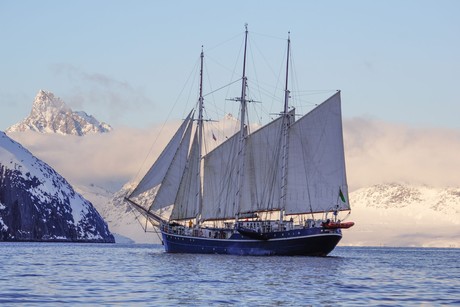
| Length | 56 metres |
|---|---|
| speed | 9 knots |
| Cabins | 16 |
S/V ‘Rembrandt Van Rijn’ was originally built as a herring lugger. The vessel was rebuilt as a three-masted passenger sailing schooner in The Netherlands in 1994 and sailed in Spitsbergen (1994 – 1996) and in Galápagos (1998 - 2001). The vessel underwent a complete rebuilding and refurbishment program in 2011. The communication and navigation equipment has been completely renewed according to the latest SOLAS regulations.
The Rembrandt van Rijn measures 56 meters in length (168 ft.), 7 meters in width and has a draft of 2, 5 meters.
•The maximum engine speed is 9 knots
•She has an experienced crew of 12 on board including two tour guides
•The ship can accommodate a maximum of 33 passengers in 16 cabins
•1 Triple Private cabin with porthole (with shower and toilet)
•6 Twin Private Inside cabins (with shower and toilet, no porthole)
•9 Twin Private cabins (with shower and toilet and porthole)
•The general interior public areas include a spacious restaurant area so that all meals can be taken together as well as separate bar area and reading table area
•There is room to relax, read and socialize
•The ship is well suited for expedition cruising among small islands and offers excellent open deck viewing areas, even when under sail. The two inflatable rubber crafts (zodiacs) enable landing and wildlife viewing opportunities in otherwise inaccessible areas.
